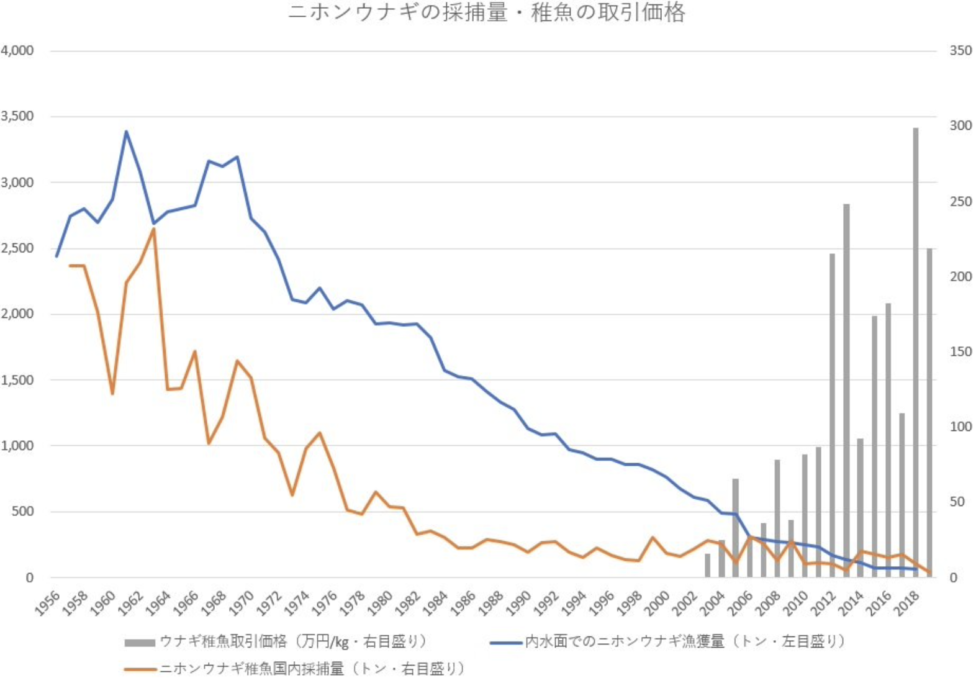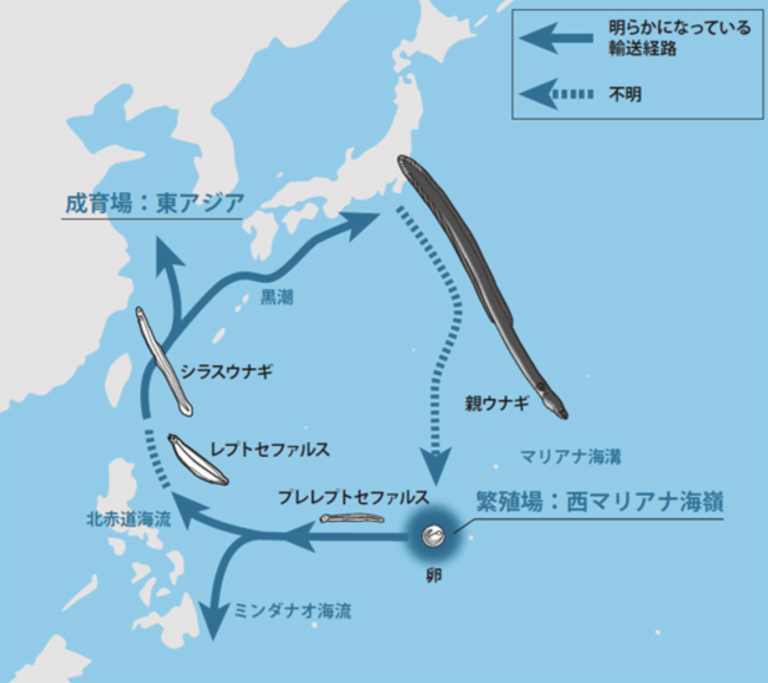はじめに
土用の丑はまだ先だ。2022年だと7月23日と8月4日だという。そもそも土用とは立春・立夏・立秋・立冬の前18日間のことだ。この期間内における丑の日を土用の丑と呼ぶ。土用の丑の日は春夏秋冬にあるけど、うなぎを食べるのは夏なので、一般的に夏の土用の丑の日のことを「土用の丑の日」と言うようだ。今日はそんなうなぎについての動画があったので、視聴してみた。日本と欧米ではうなぎに対する感覚の違いがあるようだけど、うなぎの生態系には神秘な部分がある。興味のある人は是非視聴してみてほしい。
(出典:TED動画)
うなぎの捕獲量と稚魚の価格の推移
これは動画とは関係ないけど、2018年のうなぎの漁獲量は68トンだ。これは最盛期の1961年の338トンに比べるとわずか2%となる。これほど激減して大丈夫かと心配になる。一方、漁獲量の減少と対比して急増しているのが、シラスウナギの取引金額だ。例えば2003年には1kgあたり16万円ほどだったものが、2018年には219万円まで高騰している。うなぎの産卵は成功していないので、うなぎを養殖するには稚魚が必須なので、稚魚が減少すると価格が暴騰することになる。

(出典:IT Media)
日本ウナギの海遊
日本で獲れるうなぎは、西マリアナ海嶺(かいれい)で産まれた稚魚が海遊して日本の川を上り、大きく育った親うなぎが西マリアナ海嶺に戻るという図式だ。しかし、日本の河川にダムができるたびにうなぎの漁獲高が減少するという統計もあるし、稚魚の乱獲も進んでいる。そもそもウナギ科の起源は約一億年前の白亜紀とされており、元々は海水魚だった。サケは淡水の河川で散乱して海で育つが、ウナギはその逆だ。ウナギ属の魚は世界に19種類いる。今回のテーマは大西洋で産卵するヨーロッパウナギやアメリカウナギだが、同様に太平洋やインド洋で産卵してアジアやアフリカの河川で育つウナギもいる。ウナギの進化をとどると、ウナギ科魚類に近いのは、海底から離れた中層を漂って生活する深海魚のグループであった。外洋の中層で生活していたウナギ科の祖先は、餌が豊富で競合者の少ない淡水域に進出するようになり、さらに時間をかけて、大回遊する生態に進化したのかもしれない。

(出典:wwf)
ヨーロッパウナギ
今回の動画のテーマとなっているヨーロッパウナギ(Anguilla anguilla)は、大西洋のサルガッソ海で産卵して、大西洋を回遊する。北太平洋のカルガッソ海は陸から遠く、透明度が息を呑むほど高く、浮遊性のホンダワラ属の海藻サルガッサムが生息する。このサルガッサムには、122種類もの魚の仔魚や幼魚、卵から孵化したばかりのアオウミガメ、ウミウシ、タツノオトシゴ、カニ、エビ、貝などが見つかり、海藻はこれら生物の排泄物を養分としている。ヨーロッパでもうなぎを食する週刊はあるが、蒲焼ではない。うなぎを8cmぐらいにぶつ切りして、網で焼き、レモンを絞ってかぶりつく。キリスト教では、悪や誘惑の象徴であるうなぎをクリスマスや大晦日に食べることで厄祓いをするという意味があるようだ。今回の動画では触れられていないけど、日本ではうなぎをいただくのは夏の風物詩であり、ヨーロッパではクリスマスが近づくとウナギを食べるという冬の風物詩というのも面白いと思った。

(出典:MarketPlace)
ウナギのライフサイクル
ウナギはいわば出世魚だ。幼生のレプトセファルス(Leptocephalus)、極小のシラスウナギ(Glass eel)、思春期のエルバー(elver)、年老いたイエローウナギ(Yellow eel)、成熟したシルバーウナギ(Silver eel)の5つの段階で成長する。日本ウナギは200万個から1000万個の卵を産む。卵から孵化したレプトケファルスは、平たく細長く3mmほどの透明な幼生だ。ヨーロッパウナギの幼生は300日かけて海流に乗り、6,500km離れたヨーロッパの海岸に移動する。到着することには、45mmほどの半透明なシラスウナギに変身する。淡水でも生きれるように肝臓に塩分を保持し、血液の塩分濃度を維持する。淡水域の生育環境では色素が強くなり、上流にたどり着くことには不透明なエルバーに成長する。エルバーは、河川で口に入るものはなんでも食べ始める。雑食性で10年以上かけて長さ80cmほどのイエローうなぎに成長し、この頃に性器が発達する。シルバーウナギの段階で海洋の生殖地に戻って繁殖して、新たなサイクルを始める。しかし、ウナギの行動とその起源はのうち特に繁殖については、多くがいまだに謎である。

(出典:うなぎのライフサイクル)
8つの質問
動画を視聴すると8つの質問があった。最初の3つは記述式で、残り5つは選択式だった。
Q1) What what one early proposal for the origin of eels?
ウナギの起源について古代にはどのように提案されていたかという設問だ。例えば、アリストレスは「泥から発生した」と言っていたようなので、「The origin of eels was proposed that is emerged from mud by Aristotle. 」といった感じだろうか。
Q2) When do an eel’s sex organs develop?
ウナギの性器はいつ発達するのかという設問だ。前述の通り黄色いうなぎになった段階なので、「The sex organs are developed at the stage of larger yellow eels.」だろうか。
Q3) What is the secret to the last phase of eel production?
うなぎ生産の最終的な秘密は何かという設問だ。今も解明できていないのは繁殖する場所なので、「The secret is where the eels reproduce.」か。
Q4) Many scholars, such as Aristotle found eels but had never seen them
アリストテレスなど多くの学者がウナギを発見したが、まだ確認できたいないものは何かという設問でこれは生殖なので、「mate」だろうか。
Q5) The freshwater eel lifecycle has how many distinct stages?
淡水ウナギのライフサイクルはいくつの段階があるかという設問だ。稚生、シラス、エルバー、イエロー、シルバーの5つだ。
Q6) Leptocepheli and glass eels are related to
レプトセフェリーとシラスウナギが繋がるのはイエローイール「yellow eels」だ。
Q7) Anguilla Anguilla larvae make one of the longest known marine migrations traveling on ocean currents 6,500km from the Sargasso Sea to the
アンギラの幼生は、海流に乗ってサルガッソー海から6,500kmも離れたどこに移動するかと言う設問なので、ヨーロッパ沿岸(European coast)だ。
Q8) When elvers arrive upstream to their hunting grounds, they begin everything they can. Elvers are
エルフは狩猟の場である上流に到着するとできる限りのことを始める。これは何かという設問で、エルバーは雑食性なので、「omnivores」だ。
まとめ
これまでうなぎと言うと日本の鰻を連想したが、太平洋だけではなく、インド洋にも大西洋にもウナギが生息していてその秘密はまだ全てが解明されていないことに興味を抱いた。5つの生態に成長するのを知らなかったけど、それをそれぞれ英語で説明されてもなかなかすぐには頭に残らない。ヒアリングの難しさはこのような文化や知識の不足による部分も大きい気がする。専門用語やビジネス英語が楽なのはバックグラウンドを理解できているからだろう。
以上
最後まで読んでいただきありがとうございます。
拝
参考:英文スクリプト
From Ancient Greece to the 20th century, Aristotle, Sigmund Freud, and numerous other scholars were all looking for the same thing: eel testicles. Freshwater eels, or Anguilla, could be found in rivers across Europe, but no one had ever seen them mate. And despite countless dissections(解剖), no researcher could find eel eggs or identify their reproductive organs. Devoid of data, naturalists proposed various eel origin stories. Aristotle suggested that eels spontaneously(自然に) emerged from mud. Pliny the Elder argued eels rubbed themselves against rocks, and the subsequent scrapings came to life. Eels were sid to hatch on rooftops, manifest from the gills of other fish, and even emerge from the bodies of beetles.
But the true story of eel reproduction is even more difficult to imagine. And to solve this slippery mystery, scholars would have to rethink centuries of research. Today, we know the freshwater eel lifecycle has five distinct stages: larval leptocephali, minuscule glass eels, adolescent elvers, older yellow eels, and adult silver eels. Given the radical physical differences between these phases, you would be forgiven for assuming these are different animals. In fact, that is exactly what European naturalists thought. Researchers were aware of leptocephali and glass eels, but no one guessed they were related to the elvers ad yellow eels living hundreds of kilometers upstream. Confusing matters more, eels don’t develop sex organs until late in life. And the entirety of their time in the rivers of Europe is essentially eel adolescence. So when do eels reproduce, and where do they do it? Despite its name, the life of a freshwater eel actually begins in the salty waters of the Bermuda triangle. At the height of the annual cyclone season, thousands of three-millimeter eel larvae(幼生) drift out of the Sargasso Sea.
From here, they follow migration paths to North America and Europe-continents that were much closer when eels established these routes 40 million years ago. Over the next 300 days, Anguilla Anguilla larvae ride the ocean currents 6,500 km to the coast of Europe-making one of the longest known marine migrations. By the time they arrive, they have grown approximately 45mm, and transformed into semi-transparent glass eels. It’s not just their appearance that’s changed. If most marine fish entered brackish coastal waters, their cells would swell with freshwater in a lethal(致命的な) explosion. But when glass eels reach the coast, their kidneys shift to retain more salt and maintain their blood’s salinity(濃度) levels. Swarms of these newly freshwater fish migrate up streams and rivers, sometimes piling on top of each other to clear obstacles and predators. Those that make it upstream develop into opaque(不透明な) elvers. Having finally arrived at their hunting grounds, elvers begin to eat everything they can fit into their mouths. These omnivores grow in proportion to their diets, and over the next decade, they develop into larger yellow eels. In this stage, they grow to be roughly 80cm, and finally develop sexual organs. But the last phase of eel life – and the secret of their reproduction – remains mysterious.
In 1896, researchers identified leptocephali as larval eels and deduced that they had come to Europe from somewhere in the Atlantic. However, to find this mysterious breeding ground, someone would have to perform an unthinkable survey of the ocean for larvae no larger than 30mm. Enter Johannes Schmidt. For the net 18 years, this Danish oceanographer(海洋学者) trawled the coasts of four continents, hunting down increasingly tiny leptocephali. Finally, in 1921, he found the smallest larvae yet, on the southern edge of the Sargasso Sea. Despite knowledge of their round trip migration, scientists still haven’t observed mating(交尾) in the wild or found a single eel egg. Leading theories suggest that eels reproduce in a flurry of external fertilization(外部受精), in which clouds of sperm fertilize free-floating eggs. But the powerful currents and tangling seaweed(海流) of the Sargasso Sea have made this theory difficult to confirm. Researchers don’t even know where to look, since they have yet to successfully track an eel over the course of its return migration. Until these challenges can be met, the eel’s ancient secret will continue to slip through our fingers.




